ECONOMIC OVERVIEW
- In our Latam sphere, Chile’s calendar presents a trove of important releases ahead of the BCCh’s policy announcement on the 19th, while the single most important development for global sentiment will be the possible conclusion of US debt ceiling negotiations.
- Brazil, Colombia, and Mexico also publish unemployment figures next week, all seen higher, and Brazilian Q1 GDP is forecast to show a strong start to the year—though trouble likely lies ahead to eventually prompt BCB rate cuts.
- In Mexico, non-data developments may play a bigger role. Banxico’s quarterly report and meeting minutes will help to refine expectations on when the first rate cut may come. Edomex and Coahuila’s gubernatorial elections next Sunday are also key in shaping the 2024 presidential contest outlook.
- Peru’s key data calendar has a single release next week—but it’s an important release. On Thursday, May inflation data is seen decelerating in annual and monthly terms. The decline will likely be too small, however, to prompt BCRP cuts soon.
PACIFIC ALLIANCE COUNTRY UPDATES
- We assess key insights from the last week, with highlights on the main issues to watch over the coming fortnight in the Pacific Alliance countries: Chile, Mexico and Peru.
MARKET EVENTS & INDICATORS
- A comprehensive risk calendar with selected highlights for the period May 27–June 9 across the Pacific Alliance countries and Brazil.
Chart of the Week

ECONOMIC OVERVIEW: CHILE IN THE SPOTLIGHT, PERU CPI, MEXICAN POLITICS AND BANXICO RELEASES
Juan Manuel Herrera, Senior Economist/Strategist
Scotiabank GBM
+44.207.826.5654
juanmanuel.herrera@scotiabank.com
- In our Latam sphere, Chile’s calendar presents a trove of important releases ahead of the BCCh’s policy announcement on the 19th, while the single most important development for global sentiment will be the possible conclusion of US debt ceiling negotiations.
- Brazil, Colombia, and Mexico also publish unemployment figures next week, all seen higher, and Brazilian Q1 GDP is forecast to show a strong start to the year—though trouble likely lies ahead to eventually prompt BCB rate cuts.
- In Mexico, non-data developments may play a bigger role. Banxico’s quarterly report and meeting minutes will help to refine expectations on when the first rate cut may come. Edomex and Coahuila’s gubernatorial elections next Sunday are also key in shaping the 2024 presidential contest outlook.
- Peru’s key data calendar has a single release next week—but it’s an important release. On Thursday, May inflation data is seen decelerating in annual and monthly terms. The decline will likely be too small, however, to prompt BCRP cuts soon.
It’s Chile’s world and we’re just living in it. For the next few days, at least. And this world is locker C-18 at Grand Central Terminal when it comes to market drivers next week. The single most important development to drive global, and thus regional, sentiment will be the possible conclusion of US debt ceiling negotiations that have kept traders on edge over the past few weeks.
At writing, on Friday, there are reasons to be cautiously optimistic about US markets opening on Tuesday (after the country’s long weekend) to the outlines of a debt ceiling extension bill—or an actual bill —to be voted on before the government runs out of cash and exhausts extraordinary measures sometime in June. But, we warn that there is a risk that more ‘fringe’ factions in each of the two parties refuse to back what is agreed over the weekend. These market worries go to eleven.
In our Latam sphere, Chile’s calendar presents a trove of important releases ahead of the BCCh’s policy announcement on the 19th. We start the week with the minutes to the May 12 meeting to give us a read on the bank’s appetite to cut rates in June—as we expect. This is followed by April unemployment data on Tuesday, industrial/manufacturing/copper production and retail sales data on Wednesday alongside the results of the BCCh’s traders’ survey, and ending with April monthly GDP (economic activity index) on Thursday. See our Chile section for details on what our economists in Santiago expect, but the overall message is that this will be quite a negative collection of prints—plan accordingly.
Brazil, Colombia, and Mexico also publish unemployment figures next week for April, and all three are expected to come in higher when compared to March levels. However, this would still be in line with seasonal increases in Colombia and Mexico. It is more worrying in the case of Brazil as April usually sees a slight decline from the March peaks. Nevertheless, at around 9% compared to ~12% pre-pandemic, it still looks good, and Thursday’s Q1-GDP that is expected to come in at 1.1% q/q and 2.7% y/y (from –0.2% and 1.9% in Q4) may check some of the recent building of bets on BCB cuts in Q3-23. Brazilian data are expected to turn over the next few months and will combine with the slowing in inflation to motivate the BCB to finally reduce rates towards the low-to-mid 12% area at year-end.
In Mexico, it will likely be non-data developments that play a bigger role. Banxico’s updated forecasts in its quarterly report out on Wednesday will be watched for guidance on when the bank may end its extended hold on the basis of its inflation outlook and commentary. The following day’s meeting minutes will also present the usual collection of views from officials to help us in timing the first rate cut (we currently project a 25bps cut in Q4-23). Political developments are also a key driver of sentiment in Mexican markets, and will remain so next week, as covered in today’s report in the Mexico section. Rail line and small airport disputes, canceled bank sales, and the upcoming Coahuila and Edomex gubernatorial elections will require close attention.
Peru’s key data calendar has a single release next week—but it’s an important release. On Thursday, May inflation data is seen decelerating in annual and monthly terms. Unfortunately, these will be but marginally lower prints, but at least once we round to the nearest full decimal the country’s inflation rate will fall from 8.0% to 7.9%. Our Lima economists go over their expectations for the print, while noting that progress made in inflation is not yet enough to trigger the start of rate cuts from the BCRP.
Aside from debt ceiling news, global markets have Eurozone inflation, US jobs and ISM data, Canadian Q1-GDP, and Chinese PMIs, among other releases, to ‘look forward to’ next week.
PACIFIC ALLIANCE COUNTRY UPDATES
Chile—April GDP Could be the First Negative Surprise in Economic Activity for the Central Bank's Baseline Scenario
Anibal Alarcón, Senior Economist
+56.2.2619.5465 (Chile)
anibal.alarcon@scotiabank.cl
On Tuesday, May 30, the statistical agency (INE) will publish unemployment rate data for the quarter ending in April. We project an increase in this indicator with respect to the previous three-month moving average—up to 9%—due to a strong growth in the labour force in relation to our expectation for employment growth. On jobs growth, we foresee that both public and private salaried employment will continue to show less dynamism than in previous quarters. This is mainly the case in the private sector which is losing employment due to the deterioration of labour-intensive economic sectors. We compare the INE figures with the unemployment insurance data for private salaried employment (contributors), which confirm the slowdown in job creation. In fact, with data as of January 2023, we see job losses at the margin (chart 1), which we believe would have continued in the following months. In our view, the outlook for the labour market is negative for the coming months, and would affect the dynamism of economic activity indicators, mainly private consumption, and trade.
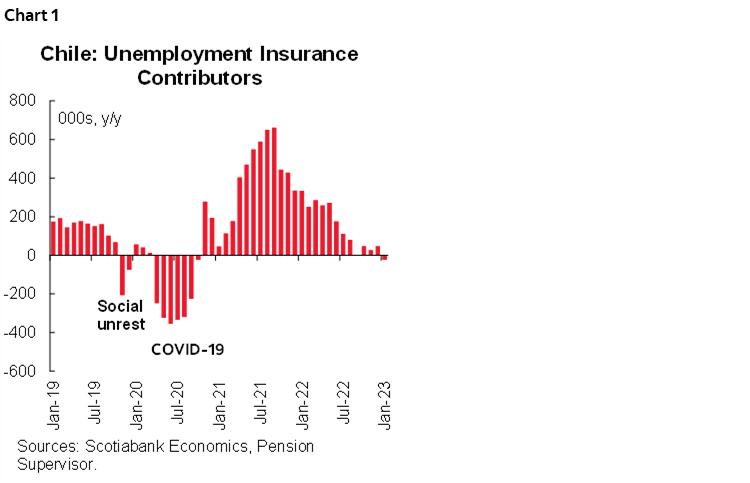
We project a 13% y/y decline in retail sales, explained by year-over-year contractions in all economic sectors except tourism, which is growing compared to last year. Based on our short-term indicators of debit card purchases (chart 2), we observe a sharp decline in demand for durable goods in April and a slowdown in purchases of semi-durable goods. Services, on the other hand, showed stabilization at low levels.
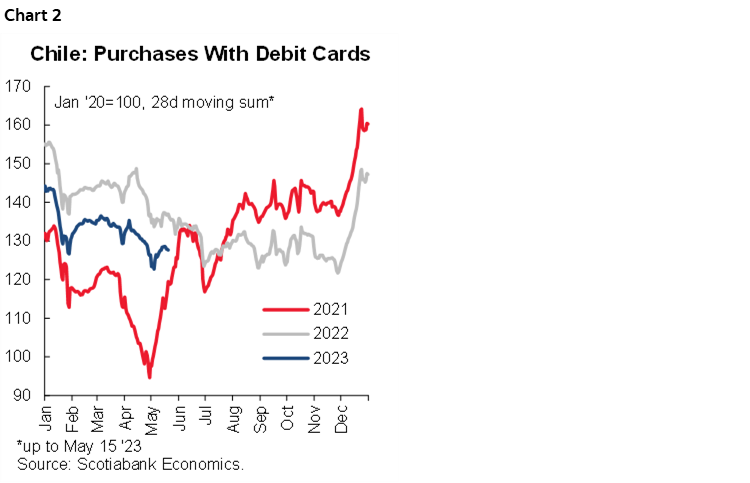
Regarding economic activity, we anticipate a 1.2% y/y contraction in GDP in April. According to our estimates, activity in trade, industry and mining will decrease compared to last year, while services would partially offset the contraction in those economic sectors, showing a slight increase on a year-on-year basis. Compared to last month, GDP would decrease by 0.7% in April, mainly due to a fall in non-mining GDP. All in all, April GDP could be the first negative surprise in economic activity in relation to the BCCh’s baseline scenario.
Mexico—Eventful Week in Mexican Politics
Eduardo Suárez, VP, Latin America Economics
+52.55.9179.5174 (Mexico)
esuarezm@scotiabank.com.mx
The past week was a rollercoaster in Mexican business and politics. It featured the government taking possession of a Ferrosur railway (details are still emerging, but different media outlets have spoken about compensation through right of way payments, or outright compensation), the end of a concession for a small private jet airport in Monterrey, and Citibank abandoned the planned sale of its Mexican arm, Banamex, after the group led by by German Larrea (the main owner of the aforementioned railway) dropped its bid. In addition, a unified opposition candidacy for the 2024 presidential election took a hit, following tensions between 2 of the 3 main opposition parties, the PRI, which currently governs the country’s most populous state Edomex (where elections are held in early-June below), and the MC party, which governs the important states of Nuevo Leon and Jalisco.
Despite the rail line and airport news, and the cancelled sale of Banamex, Mexican markets experienced what may be referred to as relatively modest volatility (particularly in fixed income and FX markets). We believe part of the relatively contained market response is due to the view that the turmoil is focused on specific markets or industries and is unlikely to affect key sectors such as tourism and manufacturing.
In addition, we’ve entered the final stretch of the electoral contests for the states of Coahuila and Estado de Mexico, with the latter being the last core bastion of the PRI party, as well as the country’s most populous state, counting 17 million inhabitants.
Recent polls suggest the opposition will lose one of its key remaining bastions in Edomex, as recent polls put Morena-PT-Green Party candidate Delfina Gomez about 10-15 points ahead of opposition (PRI-PAN-PRD) candidate Alejandra del Moral. For many, the State of Mexico election is somewhat of a wedding rehearsal for the presidential elections next year. The State of Mexico has many key elements that could impact the 2024 presidential contest, although several of them are still uncertain:
- The State of Mexico is very large in population (around 17mn), but relatively low in income per capita (MXN130k vs MXN400k in Mexico City, and MXN350k in Nuevo Leon). Many see it as a key platform for parties that see social programs as electoral tools.
- Polls suggest that the majority of voters who receive social programs vote for Morena (although we haven’t found polls on this issue more recent than from summer of 2022).
- In addition, there is speculation on why the MC party did not put forward Juan Zepeda as their candidate, as many see his no-show as a big boost to Morena’s odds to claim the governorship (Zepeda’s voter base was seen as eroding Delfina Gomez votes in lower income suburbs of Mexico City, that are part of Edomex). In turn, there is speculation that this move from the MC party signals the party won’t cooperate with the rest of the opposition in the 2024 presidential election, leading to a steep uphill battle for the opposition to regain the presidency in 2024.
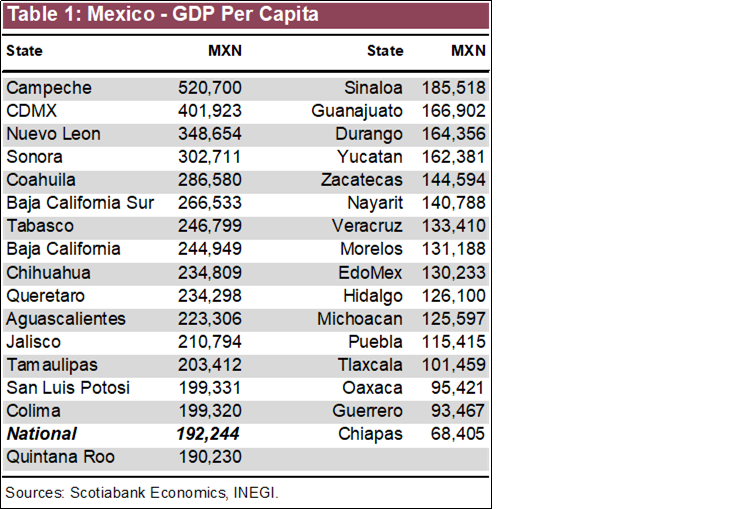
Peru—Key Data Points to a Marginally Lower Inflation in May
Guillermo Arbe, Head Economist, Peru
+51.1.211.6052 (Peru)
guillermo.arbe@scotiabank.com.pe
On Thursday, June 1, inflation data for May will be released. The key prices data that we follow suggest a monthly inflation rate of 0.34% in data to May 23 (down from 0.40% on May 9). This compares to the 0.38% increase in May 2022. In a word, inflation in May this year is looking very similar to May last year, and year-on-year inflation should not move very much from the 7.97% reading for April. If monthly inflation for May comes in at 0.34%, that would bring y/y inflation to 7.92%. Rounding to the nearest decimal, inflation would decline from 8.0% to 7.9%. But we’re splitting hairs as the difference would be marginal. The broader picture is, first, that inflation is likely to remain stable in May, and second, that Inflation is likely to sit just below 8% for a second consecutive month.
Due to base comparisons with 2022, we continue to expect a sharper decline in inflation in June–July, with a more moderate decrease, thereafter, reaching our full-year forecast of 5.0% at year-end.
The marginal improvement we expect for May would not be nearly enough for the BCRP to begin to lower rates. Adding to this, BCRP president Julio Velarde stated earlier this week that inflation was proving stickier than expected, which suggests that the BCRP will need stronger evidence for it to build up the conviction it needs to begin to consider reducing its reference rate (chart 3). Given this, we feel comfortable with our expectation that the BCRP will not reduce rates until Q4, and then only by 50 bps, to close the year at 7.25%.
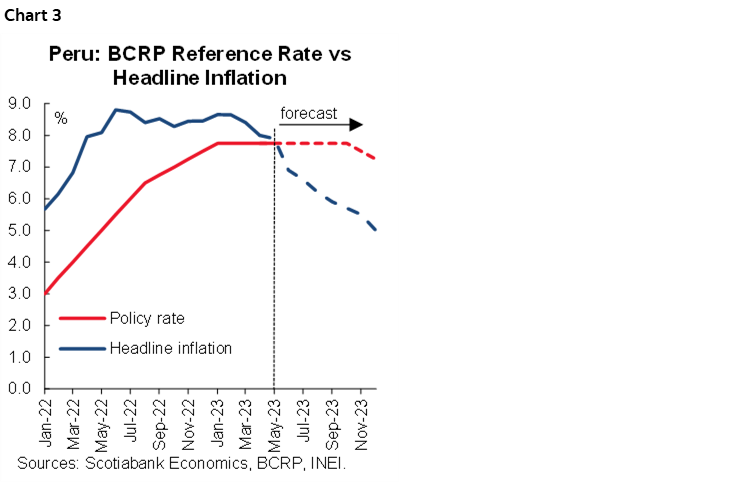
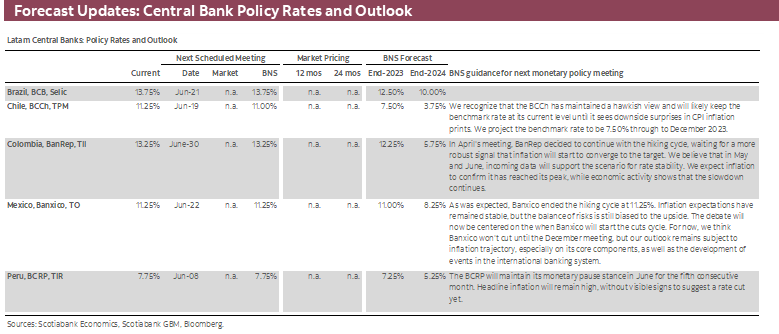
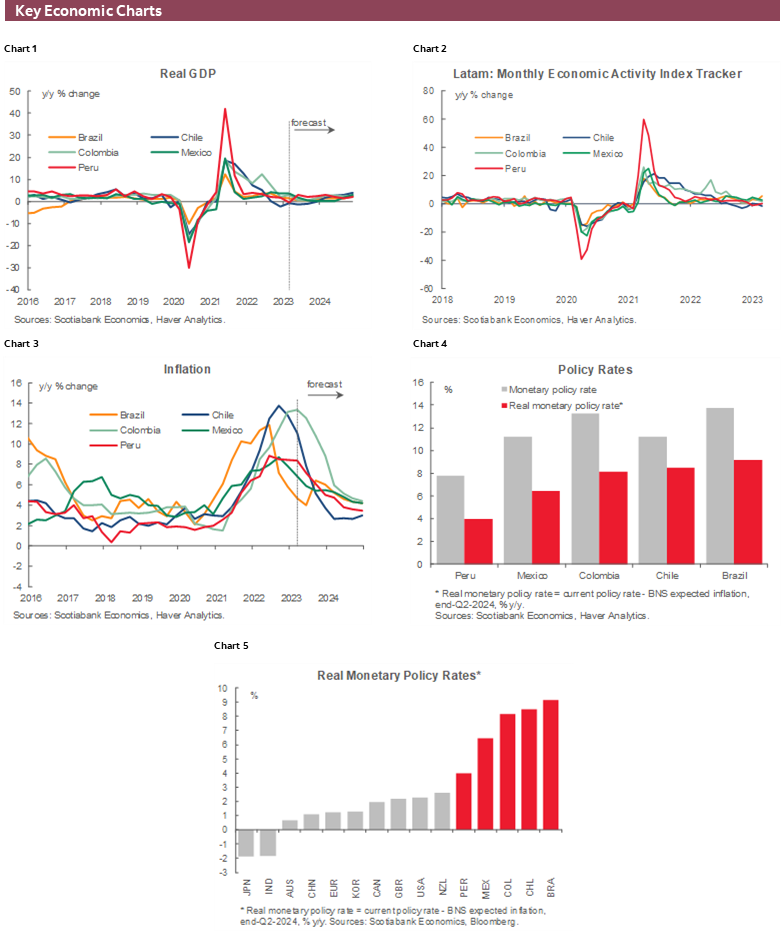
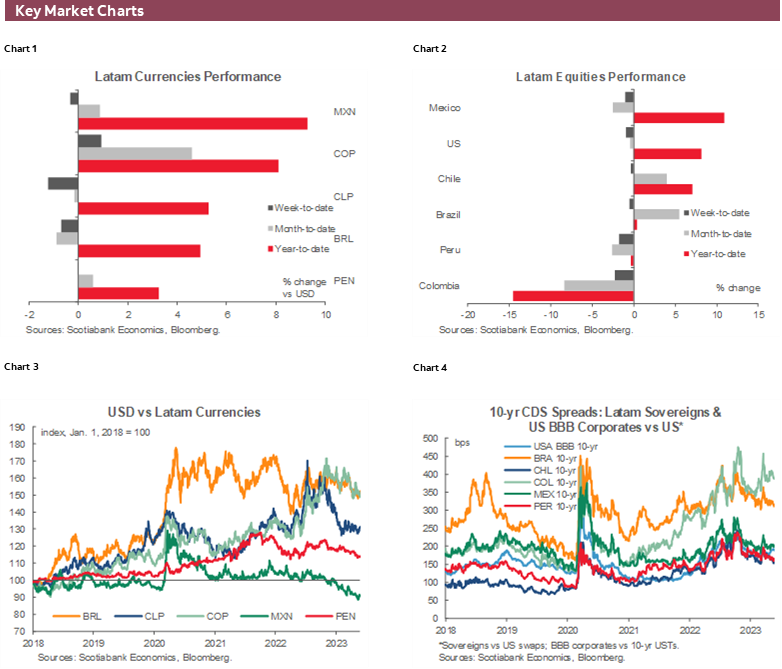
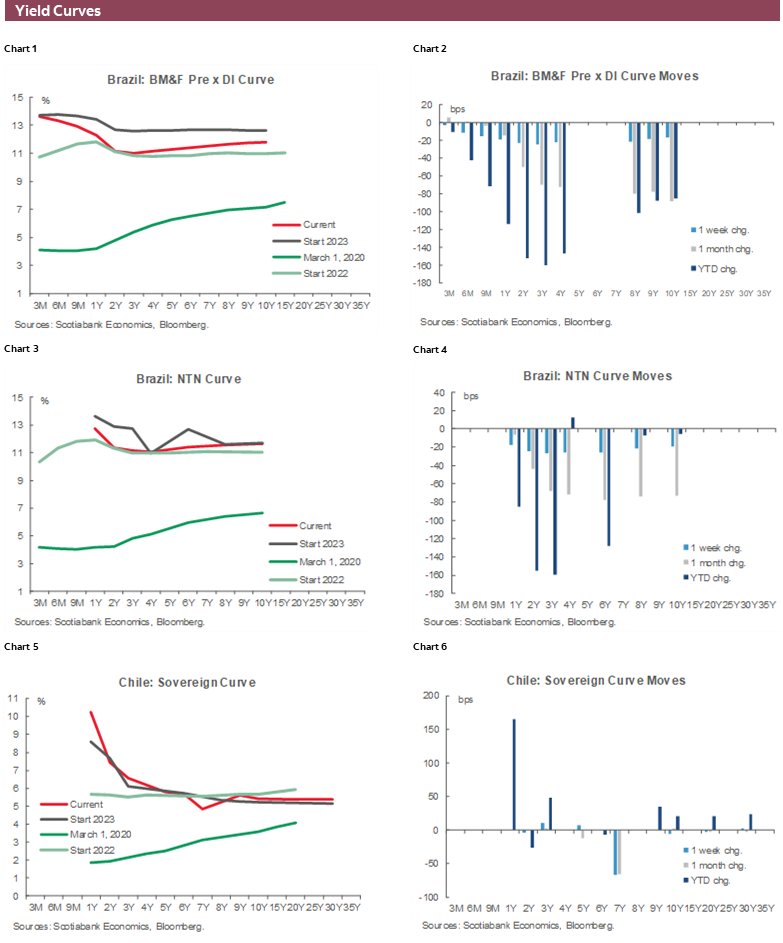
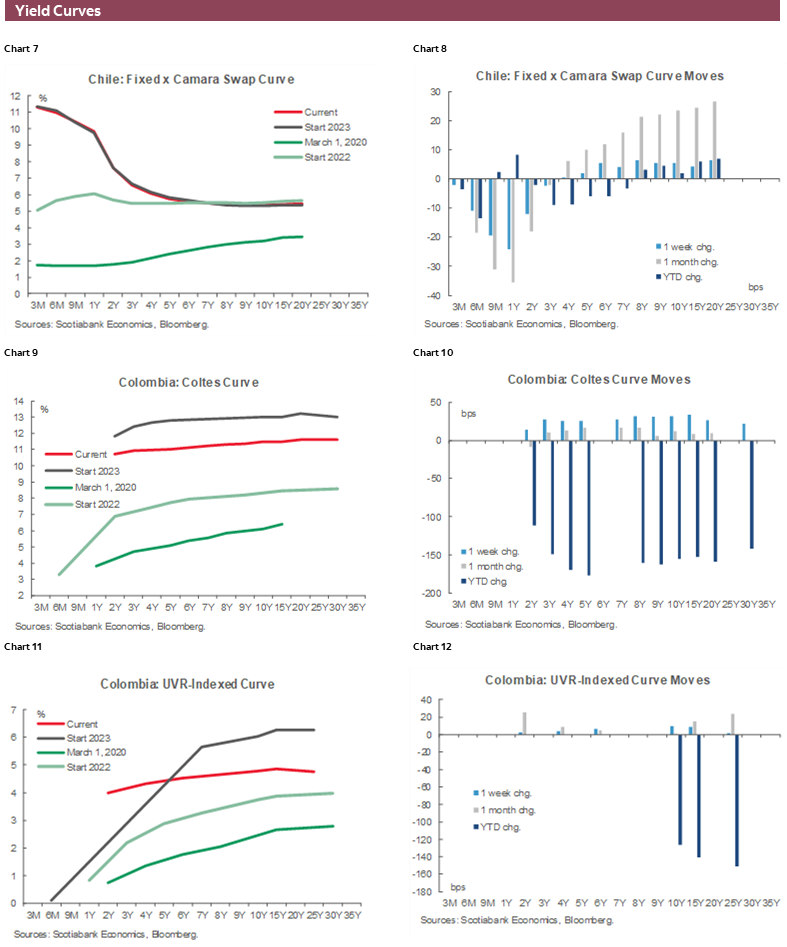
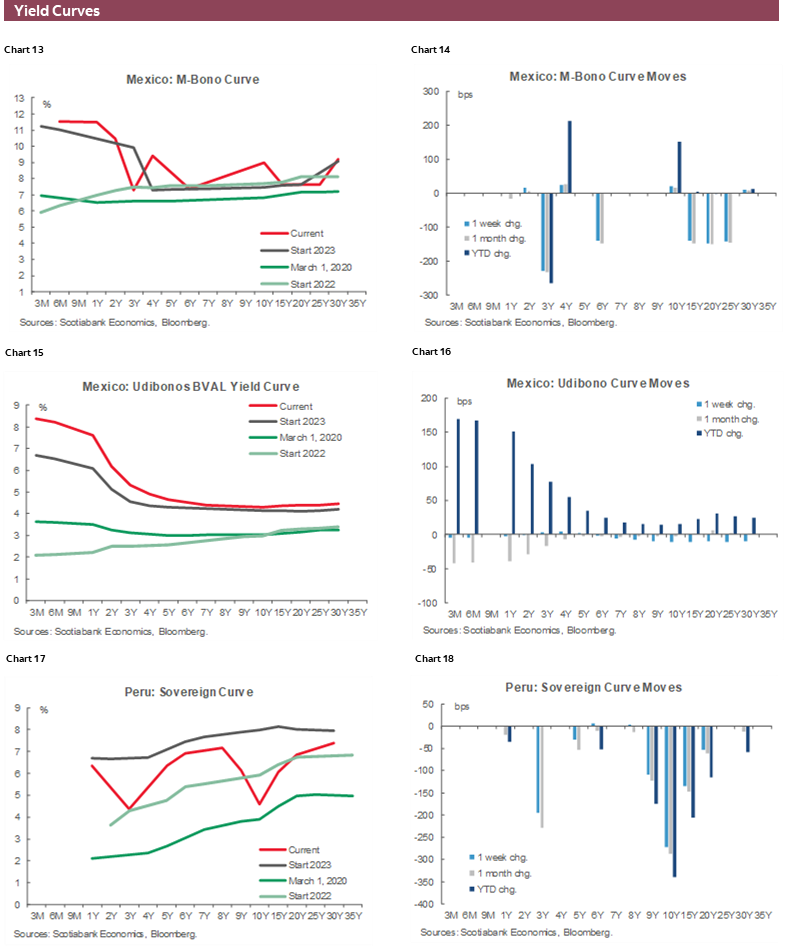
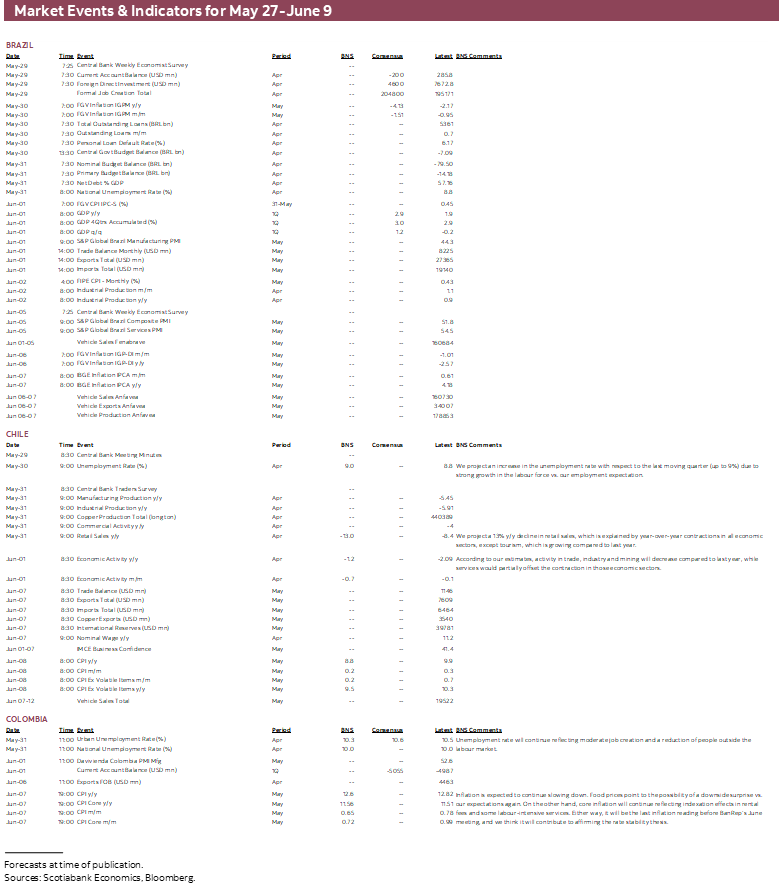
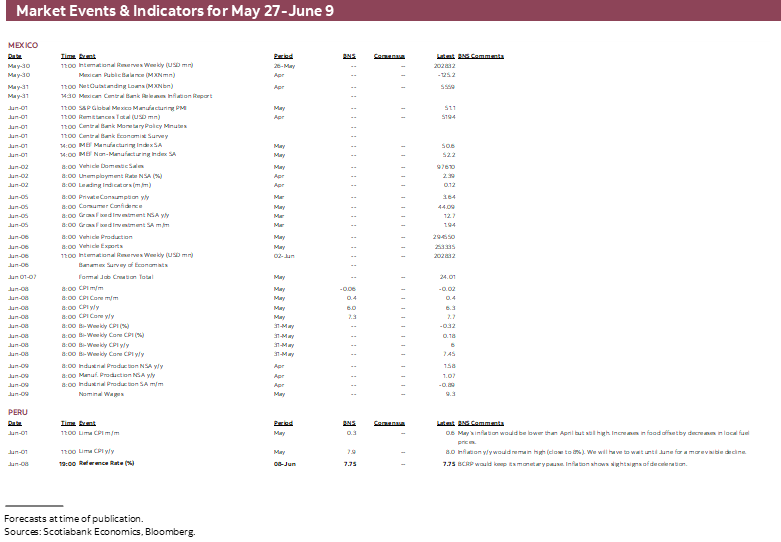
| LOCAL MARKET COVERAGE | |
| CHILE | |
| Website: | Click here to be redirected |
| Subscribe: | anibal.alarcon@scotiabank.cl |
| Coverage: | Spanish and English |
| COLOMBIA | |
| Website: | Click here to be redirected |
| Subscribe: | jackeline.pirajan@scotiabankcolptria.com |
| Coverage: | Spanish and English |
| MEXICO | |
| Website: | Click here to be redirected |
| Subscribe: | estudeco@scotiacb.com.mx |
| Coverage: | Spanish |
| PERU | |
| Website: | Click here to be redirected |
| Subscribe: | siee@scotiabank.com.pe |
| Coverage: | Spanish |
DISCLAIMER
This report has been prepared by Scotiabank Economics as a resource for the clients of Scotiabank. Opinions, estimates and projections contained herein are our own as of the date hereof and are subject to change without notice. The information and opinions contained herein have been compiled or arrived at from sources believed reliable but no representation or warranty, express or implied, is made as to their accuracy or completeness. Neither Scotiabank nor any of its officers, directors, partners, employees or affiliates accepts any liability whatsoever for any direct or consequential loss arising from any use of this report or its contents.
These reports are provided to you for informational purposes only. This report is not, and is not constructed as, an offer to sell or solicitation of any offer to buy any financial instrument, nor shall this report be construed as an opinion as to whether you should enter into any swap or trading strategy involving a swap or any other transaction. The information contained in this report is not intended to be, and does not constitute, a recommendation of a swap or trading strategy involving a swap within the meaning of U.S. Commodity Futures Trading Commission Regulation 23.434 and Appendix A thereto. This material is not intended to be individually tailored to your needs or characteristics and should not be viewed as a “call to action” or suggestion that you enter into a swap or trading strategy involving a swap or any other transaction. Scotiabank may engage in transactions in a manner inconsistent with the views discussed this report and may have positions, or be in the process of acquiring or disposing of positions, referred to in this report.
Scotiabank, its affiliates and any of their respective officers, directors and employees may from time to time take positions in currencies, act as managers, co-managers or underwriters of a public offering or act as principals or agents, deal in, own or act as market makers or advisors, brokers or commercial and/or investment bankers in relation to securities or related derivatives. As a result of these actions, Scotiabank may receive remuneration. All Scotiabank products and services are subject to the terms of applicable agreements and local regulations. Officers, directors and employees of Scotiabank and its affiliates may serve as directors of corporations.
Any securities discussed in this report may not be suitable for all investors. Scotiabank recommends that investors independently evaluate any issuer and security discussed in this report, and consult with any advisors they deem necessary prior to making any investment.
This report and all information, opinions and conclusions contained in it are protected by copyright. This information may not be reproduced without the prior express written consent of Scotiabank.
™ Trademark of The Bank of Nova Scotia. Used under license, where applicable.
Scotiabank, together with “Global Banking and Markets”, is a marketing name for the global corporate and investment banking and capital markets businesses of The Bank of Nova Scotia and certain of its affiliates in the countries where they operate, including; Scotiabank Europe plc; Scotiabank (Ireland) Designated Activity Company; Scotiabank Inverlat S.A., Institución de Banca Múltiple, Grupo Financiero Scotiabank Inverlat, Scotia Inverlat Casa de Bolsa, S.A. de C.V., Grupo Financiero Scotiabank Inverlat, Scotia Inverlat Derivados S.A. de C.V. – all members of the Scotiabank group and authorized users of the Scotiabank mark. The Bank of Nova Scotia is incorporated in Canada with limited liability and is authorised and regulated by the Office of the Superintendent of Financial Institutions Canada. The Bank of Nova Scotia is authorized by the UK Prudential Regulation Authority and is subject to regulation by the UK Financial Conduct Authority and limited regulation by the UK Prudential Regulation Authority. Details about the extent of The Bank of Nova Scotia's regulation by the UK Prudential Regulation Authority are available from us on request. Scotiabank Europe plc is authorized by the UK Prudential Regulation Authority and regulated by the UK Financial Conduct Authority and the UK Prudential Regulation Authority.
Scotiabank Inverlat, S.A., Scotia Inverlat Casa de Bolsa, S.A. de C.V, Grupo Financiero Scotiabank Inverlat, and Scotia Inverlat Derivados, S.A. de C.V., are each authorized and regulated by the Mexican financial authorities.
Not all products and services are offered in all jurisdictions. Services described are available in jurisdictions where permitted by law.

